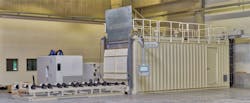Scaling Heat-Treating Expertise to Match Opportunities
Being an automotive supplier means sifting through forecasts and monitoring trends to determine what decisions are being made, what changes are taking hold, what concepts are budding in the minds of the designers (and regulators, theorists, and of course car buyers) that will define your customer base. Anything you think is constant about the current automotive market seems open to change. Many developments seem possible, but far from certain.
Except for aluminum, including aluminum castings. There, everything is growing. And automotive aluminum is more than a trend: the automotive consulting/research firm Ducker Worldwide predicts automakers will continue to increase their products’ total aluminum content from 397 lbs./vehicle (PPV) in 2015 to 565 PPV by 2028, to 16% of total vehicle weight.
But for aluminum foundries and diecasters, supplying castings to automakers demands more than a forecast. There are other issues to be addressed, including the necessity to heat-treat aluminum castings to achieve the hardness necessary for automotive applications. Cast aluminum parts are prone to brittleness, meaning they cannot be used in high-stress applications, and making the castings larger or thicker to offset that problem contravenes the lightweighting objectives that favor aluminum in the first place.
Nor is heat treating an ordinary capability for aluminum casting producers. It’s a process that requires capital investment, operating capital, and particularly the metallurgical expertise to conduct industrial heating effectively and reliably.
One heat-treating expert is Markus Belte, the developer of a process for heat-treating structural components for the first compact vehicle with an all-aluminum chassis. Later, he introduced heat treatment for engine mounts, and then the first heat-treatment process for diesel engine cylinder heads and blocks.
Belte’s developments also include polymer quenching, a sequence of heating and cooling steps that impart high-strength material properties automotive customers require of aluminum castings.
Now, the demand for automotive aluminum castings has given rise to a new concept: centralized management and handling of the heat-treating process, with customized process expertise. Belte founded Aluvation, which via its Aluvation Technology Center in Paderborn, Germany, offers heat-treatment to aluminum parts manufacturers not in capital-intensive installations but via a modular, digitalized, and transportable process.
By using mobile, scalable, and standardized furnaces designed like shipping containers, Aluvation oversees high-tech heat-treatment activities that are connected via an Industry 4.0-tuned data network. Customers rent a heat-treatment plant, including process development service, according to their specific needs and the particular volume requirements; it can be installed within days; and integrated into a production program. The electric-powered furnace modules can operate anywhere in the world, centrally controlled from the Aluvation Technology Center.
Heat-treatment (T5, T6, and T7) capabilities range to allow different metalcasting operations to choose the right type of installation for their products and business plan. Stress relief, recrystallization annealing, stabilization annealing, and soft annealing are offered.
One or more continuously variable electric-heated modules can be selected, to perform heat-treatment in a temperature range of 80-550°C, with temperature uniformity of +/-3°C. Maximum system dimensions are 5,400×1,700×1,700 mm, for parts weighing up to 6 metric tons.
With truck transportation available, the heat-treating system can be set-up and commissioned in one to five days (depending on the number of linked modules), and all process planning, monitoring, documentation, and archiving is managed at the ATC in Germany.
Turning a traditional, capital-intensive industrial process into a scalable technology that metalcasters can use to ride a market trend demands tapping into another trend. Aluvation is using an Internet of Things middleware platform offered by Relayr to convey the process information from customers sites, plus the Google Cloud platform to host the analytical and management computing activity. Belte called the two technologies “a crucial part of our business model.
“The Relayr solution not only enables basic tracking functions, it also provides sophisticated predictive maintenance allowing us to provide uptime guarantees to our clients, remote monitoring, and adjustment of the production process from our central technology center, and the new business concept of aluminum heat-treatment as a service,” the Aluvation CEO said.
